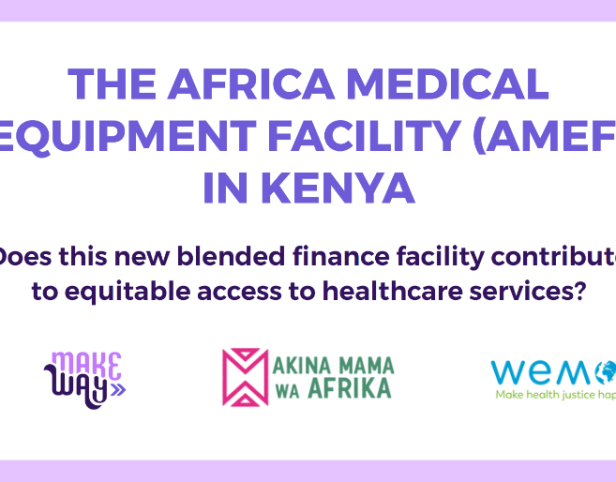
A joint case study by Akina Mama wa Afrika and Wemos critically analysing the design and rollout of The Africa Medical Equipment Facility (AMEF) illustrates that AMEF has failed to make health care accessible and equitable for vulnerable populations.
The AMEF is a blended finance facility created to support private healthcare providers in seven African countries (potentially more in the future) to buy medical equipment from manufacturers by de-risking loans provided by local banks. The facility is carried out by the International Finance Corporation (IFC), the private sector arm of the World Bank. It seeks to increase healthcare provision, foster innovation, and increase investment in the private health sector by demonstrating its bankability. Kenya, where this study was conducted, is one of the two countries where the AMEF has been implemented thus far. AMEF Kenya is financially supported by the Global Financing Facility for Women, Children and Adolescents (GFF).
Even though AMEF was established to make health care accessible for vulnerable populations, we found that higher-end, medium-to-large private facilities can access these loans but not small, low-end healthcare providers. It is unlikely then that the AMEF will contribute to universal and equitable access to healthcare services and reach the key populations within GFF’s target group. Since essential services for Reproductive, Maternal, Newborn, Child and Adolescent Health and Nutrition (RMNCAH-N) are delivered through the public system, investment in the AMEF could divert scarce GFF resources.
From interviews, we learned that civil society representatives were often unaware of the initiative. Most interviewees raised criticism on the lack of support to local manufacturers. Civil society representatives and some healthcare officials expressed concerns that the AMEF, like other financing facilities focused on private healthcare, could hamper progress towards health equity in Kenya.
Based on our findings, we recommend that policymakers reassess their blended finance approach, support local manufacturers directly or through the African Union, and to invest and strengthen public healthcare provision.
Recommendations
Based on the findings, Wemos and Akina Mama wa Afrika propose the following recommendations to the policymakers directly or indirectly involved in the project.
- The GFF
Since this initiative does not reach people living in poverty we recommend reassessing their blended finance approach and their support to the AMEF in particular. - The World Bank Group and its arms – the International Finance Corporation (IFC) and International Development Association (IDA)
We recommend assessing investments in the health sector with a health equity lens. To expand access to medical equipment, the World Bank should consider directly supporting local (Kenyan or African in general) manufacturers, or work with the African Union and its existing initiatives, like the Africa Medical Supplies Platform – rather than financing private healthcare providers. - The Kenyan government
We recommend to invest in and strengthen public healthcare provision. This should be financed through progressive taxation, and by increasing the amount of National Health Insurance Fund resources allocated to the public sector.
Download the AMEF study here: Study-of-the-Africa-Medical-Equipment-Facility-in-Kenya_2022

